-
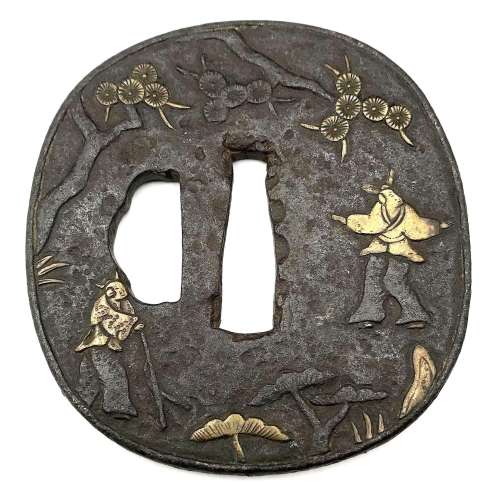 Relatively thick iron tsuba of rounded square form with slightly elevated rim decorated in carving (sukidashi-bori) and yellow brass (shinchū) inlay (suemon-zōgan) with legendary creatures (humans with cow heads) in a pine tree forrest on the face, and a horned man with a stick hunting a rabbit in the woods on the reverse. Large hitsu-ana possibly cut off later on. In the beginning of the 20th century such tsuba were usually attributed to Fushimi-Kaga school. This one may be attributed to either Ōnin or to Heianjō. The latter seems most plosible because of the thick web and dull patina. The technique may also be called "shinchū-zōgan". Momoyama or early Edo period. Unsigned. Dimensions: 72.3 x 68.4 x 4.1 mm
Relatively thick iron tsuba of rounded square form with slightly elevated rim decorated in carving (sukidashi-bori) and yellow brass (shinchū) inlay (suemon-zōgan) with legendary creatures (humans with cow heads) in a pine tree forrest on the face, and a horned man with a stick hunting a rabbit in the woods on the reverse. Large hitsu-ana possibly cut off later on. In the beginning of the 20th century such tsuba were usually attributed to Fushimi-Kaga school. This one may be attributed to either Ōnin or to Heianjō. The latter seems most plosible because of the thick web and dull patina. The technique may also be called "shinchū-zōgan". Momoyama or early Edo period. Unsigned. Dimensions: 72.3 x 68.4 x 4.1 mm -
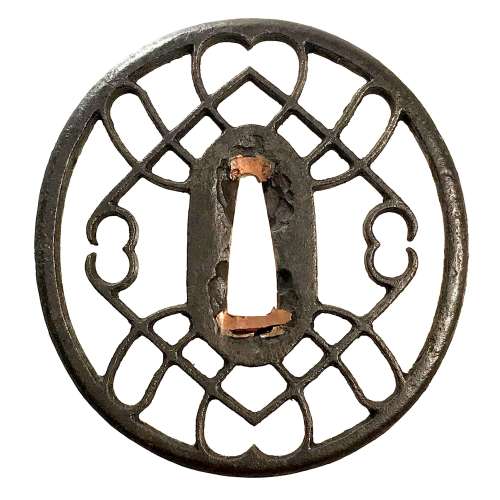 Iron tsuba of oval form with the motif of horse trappings in openwork (sukashi). Copper sekigane. Iron bones (tekkotsu) on the rim.
Iron tsuba of oval form with the motif of horse trappings in openwork (sukashi). Copper sekigane. Iron bones (tekkotsu) on the rim.Size: 80.4 x 75.8 x 5.2 mm
NBTHK Certificate №454567, allegedly saying that it is Akasaka School, Muromachi period. A look-a-like tsuba in Robert. E. Haynes Catalog #7, 1983 on page 57 under №48 is described as follows: "A masterpiece second period Owari sukashi tsuba. The plate is of beautiful color and quality almost like velvet. The design is very hard to discern, it might be the horse trappings, or even a moon. The style and type of Owari tsuba shows the great tradition of the Momoyama period and why it was the renaissance in time, as well as the arts produced, through the long history of all Japanese art. Ca. 1580. Ht. 7.7 cm, Th. (center) 5.5 mm, (edge) 5.25 to 5.75 mm."I believe we can safely attribute this tsuba to Owari School, c. 1580.
Robert. E. Haynes Catalog #7, 1983, p. 57, №48.
-
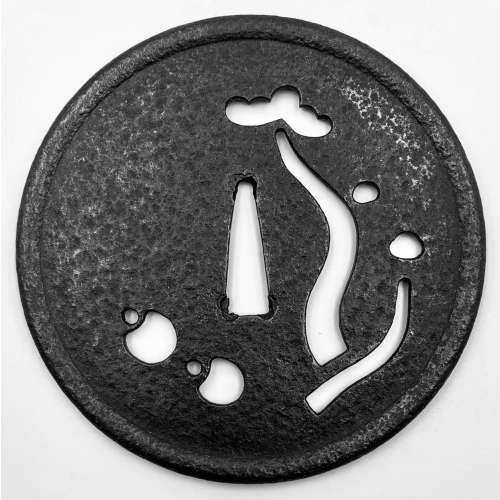
Iron tsuba of circular form with design of pine trees (matsu) and monkey toys (kukurizaru) in openwork (ko-sukashi). Ko-Katchushi school.
Raised rim (mimi) with iron bones (tekkotsu). Size: Diameter: 99.5 mm; Thickness: 2.1 mm at centre; 4.3 mm at the rim.Early Muromachi period: 15th century (Kakitsu - Bun'an era, 1441 - 1449).
-
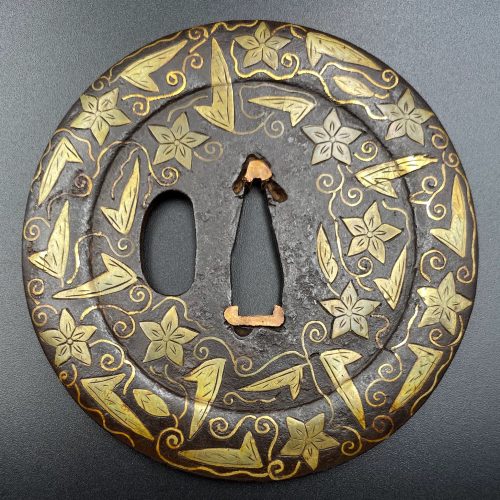 Iron tsuba of the round form (丸型, maru–gata), decorated with brass flat inlay (平象嵌, hira-zōgan) of bellflowers, leaves, and vines on both sides, inlaid brass is carved in low relief; wide rim (dote-mimi) also inlaid; the plate is pierced with hitsu-ana (probably original); nakago-ana plugged with copper sekigane. Dimensions: Height: 84.1 mm; Width: 82.0 mm; Thickness (centre): 2.8 mm; mimi is 11.8 mm wide and 4.7 mm thick. Produced at the end of the 16th century, in the Momoyama period (1674–1703).
Iron tsuba of the round form (丸型, maru–gata), decorated with brass flat inlay (平象嵌, hira-zōgan) of bellflowers, leaves, and vines on both sides, inlaid brass is carved in low relief; wide rim (dote-mimi) also inlaid; the plate is pierced with hitsu-ana (probably original); nakago-ana plugged with copper sekigane. Dimensions: Height: 84.1 mm; Width: 82.0 mm; Thickness (centre): 2.8 mm; mimi is 11.8 mm wide and 4.7 mm thick. Produced at the end of the 16th century, in the Momoyama period (1674–1703). -
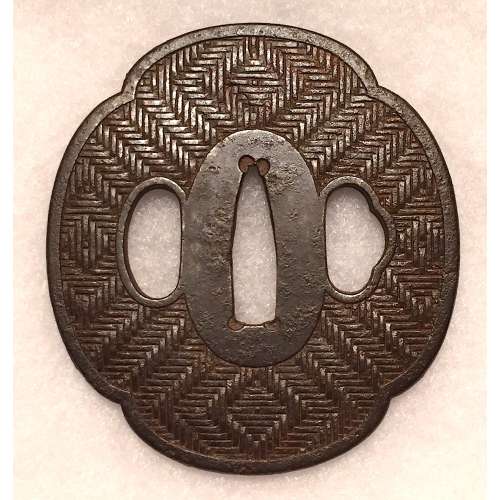 Iron tsuba with brown patina in mokkō-gata form with woven design. Size: 72 x 67 x 5 mm.
Iron tsuba with brown patina in mokkō-gata form with woven design. Size: 72 x 67 x 5 mm. -
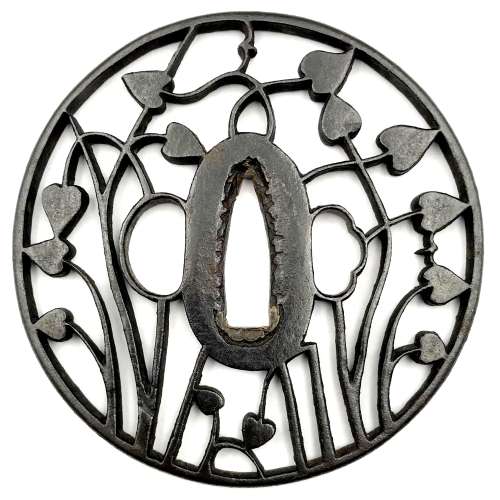 Kyo-sukashi iron tsuba of round form with design of hollyhock (aoi ) and wild geese. Slightly rounded rim. Copper sekigane. Momoyama period, late 16th - early 17th century. Height: 82.6 mm, Width: 82.1 mm, Thickness at seppa-dai: 4.5 mm. NTHK (Nihon Token Hozon Kai) certified.
Kyo-sukashi iron tsuba of round form with design of hollyhock (aoi ) and wild geese. Slightly rounded rim. Copper sekigane. Momoyama period, late 16th - early 17th century. Height: 82.6 mm, Width: 82.1 mm, Thickness at seppa-dai: 4.5 mm. NTHK (Nihon Token Hozon Kai) certified. -
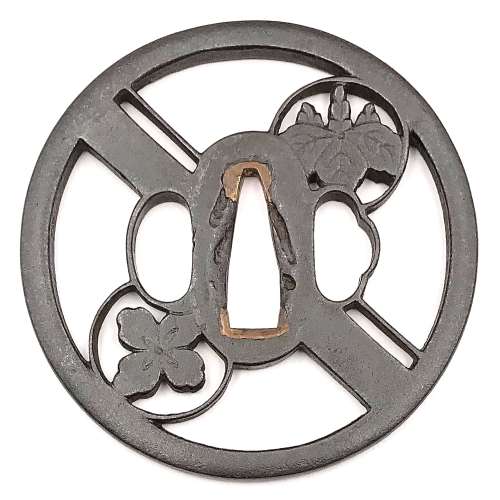 Iron tsuba of round form with design of double crossbar and two family crests (hikiryo-ni-kamon) in openwork (sukashi). Squared rim. Copper sekigane. Owari school. Early Edo period: Late 17th century (Kanbun / Enppo era). Height: 80.9 mm. Width: 80.8 mm. Rim thickness: 5.0 mm. Center thickness: 4.6 mm. Provenance: Sasano Masayuki Collection, № 172: "A paulownia and a clover are diagonally opposite two crossbars. This expressive design suggests a Higo origin, but the iron and the finish are certainly of the Owari school. Work of this nature may have been influenced by Hayashi Matashichi (1613-1699)."
Iron tsuba of round form with design of double crossbar and two family crests (hikiryo-ni-kamon) in openwork (sukashi). Squared rim. Copper sekigane. Owari school. Early Edo period: Late 17th century (Kanbun / Enppo era). Height: 80.9 mm. Width: 80.8 mm. Rim thickness: 5.0 mm. Center thickness: 4.6 mm. Provenance: Sasano Masayuki Collection, № 172: "A paulownia and a clover are diagonally opposite two crossbars. This expressive design suggests a Higo origin, but the iron and the finish are certainly of the Owari school. Work of this nature may have been influenced by Hayashi Matashichi (1613-1699)." -
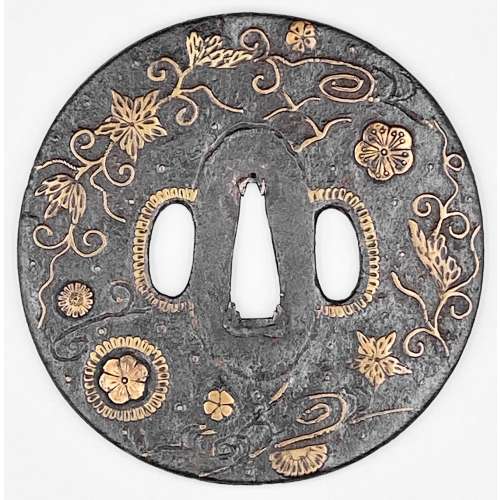 Iron tsuba of round form adorned with the design of stars, wild geese, floating blossoms, leaves and tendrils realized in brass inlay. The inlay technique includes suemon-zōgan and ten-zōgan. Two smaller openings (hitsu-ana) surrounded by a scalloped brass border. The seppa-dai border inlay is missing, as well as a few other fragments of inlay on both sides. Sword cut at 12 o'clock on the reverse. A tsuba with a strong autumnal connotation, which once belonged to a great battle weapon. One of only three known jūyō Ōnin tsuba. Translation of the paper, issued by the Japanese sword fittings (tosogu) examination board: Designated as jūyō-tosogu at the 34th jūyō-shinsa held on April 14th 1988 Kaki-karimon zōgan-tsuba (花卉雁文象嵌鐔) — Tsuba with zōgan design of flowers and wild geese. Mumei: Onin (応仁) Tokyo. Nakasono Tokumi (中園とくみ) Measurements: height 9.5 cm, width 9.4 cm, thickness at rim 0.35 cm Interpretation: marugata, iron, brass zōgan, two hitsu-ana Time: end of Muromachi Explanation: Ōnin-tsuba are thin iron ita-tsuba which show a brass zōgan ornamentation. All of them are mumei and there is the theory that they were made in the Onin era (1467-1469) although today more and more the theory is accepted that they are in general late Muromachi period works. There are two kinds of brass zōgan interpretations: One depicts irregularly arranged tachibana branches, wild geese, chrysanthemums, flowers, or karakusa for example, and the other one shows punctual zōgan elements, which are referred to as hoshi-zōgan or ro-zōgan, and concentrical zōgan elements between the nakago-ana and the rim. The latter interpretations might also be accompanied by simple ko-sukashi in the form of butterflies, clouds, hats, or stylized mountains. This tsuba is a typical work from the former category. It is large and feels massive and the powerful and impressive zōgan and the excellent iron make it a highly tasteful piece. Back side: Issued to: Nakasono Tokumi Address: Tokyo-to, Suginami-ku, Kamitakaido 2-17-26 Date of issue: May 30th 1989
Iron tsuba of round form adorned with the design of stars, wild geese, floating blossoms, leaves and tendrils realized in brass inlay. The inlay technique includes suemon-zōgan and ten-zōgan. Two smaller openings (hitsu-ana) surrounded by a scalloped brass border. The seppa-dai border inlay is missing, as well as a few other fragments of inlay on both sides. Sword cut at 12 o'clock on the reverse. A tsuba with a strong autumnal connotation, which once belonged to a great battle weapon. One of only three known jūyō Ōnin tsuba. Translation of the paper, issued by the Japanese sword fittings (tosogu) examination board: Designated as jūyō-tosogu at the 34th jūyō-shinsa held on April 14th 1988 Kaki-karimon zōgan-tsuba (花卉雁文象嵌鐔) — Tsuba with zōgan design of flowers and wild geese. Mumei: Onin (応仁) Tokyo. Nakasono Tokumi (中園とくみ) Measurements: height 9.5 cm, width 9.4 cm, thickness at rim 0.35 cm Interpretation: marugata, iron, brass zōgan, two hitsu-ana Time: end of Muromachi Explanation: Ōnin-tsuba are thin iron ita-tsuba which show a brass zōgan ornamentation. All of them are mumei and there is the theory that they were made in the Onin era (1467-1469) although today more and more the theory is accepted that they are in general late Muromachi period works. There are two kinds of brass zōgan interpretations: One depicts irregularly arranged tachibana branches, wild geese, chrysanthemums, flowers, or karakusa for example, and the other one shows punctual zōgan elements, which are referred to as hoshi-zōgan or ro-zōgan, and concentrical zōgan elements between the nakago-ana and the rim. The latter interpretations might also be accompanied by simple ko-sukashi in the form of butterflies, clouds, hats, or stylized mountains. This tsuba is a typical work from the former category. It is large and feels massive and the powerful and impressive zōgan and the excellent iron make it a highly tasteful piece. Back side: Issued to: Nakasono Tokumi Address: Tokyo-to, Suginami-ku, Kamitakaido 2-17-26 Date of issue: May 30th 1989 -
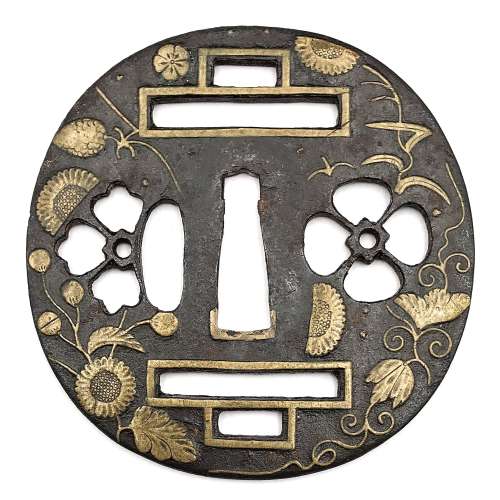 Iron tsuba of round form decorated with chrysanthemums, pine cones and needles, pampas grass, vines, cherry blossoms, and wild geese in brass inlay (suemon-zōgan) and pierced with designs of water clover (denjiso) and half bellflower (or karahana) to the left and to the right of nakago-ana as well as double bars above and below nakago-ana (possibly with the meaning of number 2 or ordinal 2nd). Most probably the sukashi elements here are the family crests (mon). Unsigned. Ōnin school. Muromachi period; 15th or 16th century. Height: 82.1 mm; Width: 80.9 mm; Thickness at seppa-dai: 2.4 mm NBTHK # 2003827: Tokubetsu Hozon Tosogu Kanteisho (特別保存刀装具鑑定書) - "Extraordinarily Worthy of Preservation".
Iron tsuba of round form decorated with chrysanthemums, pine cones and needles, pampas grass, vines, cherry blossoms, and wild geese in brass inlay (suemon-zōgan) and pierced with designs of water clover (denjiso) and half bellflower (or karahana) to the left and to the right of nakago-ana as well as double bars above and below nakago-ana (possibly with the meaning of number 2 or ordinal 2nd). Most probably the sukashi elements here are the family crests (mon). Unsigned. Ōnin school. Muromachi period; 15th or 16th century. Height: 82.1 mm; Width: 80.9 mm; Thickness at seppa-dai: 2.4 mm NBTHK # 2003827: Tokubetsu Hozon Tosogu Kanteisho (特別保存刀装具鑑定書) - "Extraordinarily Worthy of Preservation". -
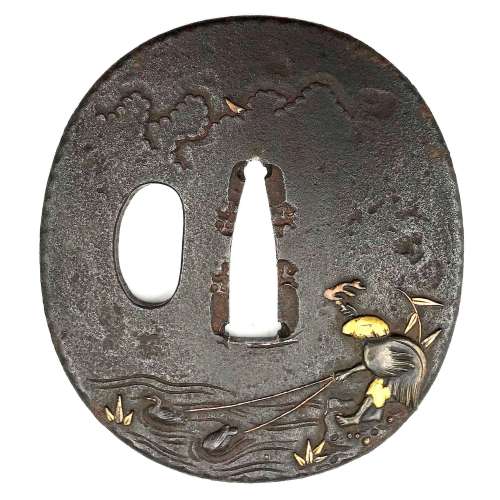 Iron tsuba of oval form carved and inlaid in gold and copper with cormorant fisherman in disguise. Unsigned. Dimensions: 67.7 mm x 61.5 mm x 3.8 mm (at seppa-dai) Edo period: 18th century. "Since Nara period, Japanese fishermen in small boats have used cormorants (u) to catch river fish at night, binding the necks of the birds so that the fish are not swallowed. [...] The bird and the work it performs are symbols of selfless devotion to one's master and keen eyesight." - from Merrily Baird. Symbols of Japan. Thematic motifs in art and design. Rizzoli international publications, Inc., 2001; p. 104. See also TSU-0212 and TSU-0096
Iron tsuba of oval form carved and inlaid in gold and copper with cormorant fisherman in disguise. Unsigned. Dimensions: 67.7 mm x 61.5 mm x 3.8 mm (at seppa-dai) Edo period: 18th century. "Since Nara period, Japanese fishermen in small boats have used cormorants (u) to catch river fish at night, binding the necks of the birds so that the fish are not swallowed. [...] The bird and the work it performs are symbols of selfless devotion to one's master and keen eyesight." - from Merrily Baird. Symbols of Japan. Thematic motifs in art and design. Rizzoli international publications, Inc., 2001; p. 104. See also TSU-0212 and TSU-0096 -
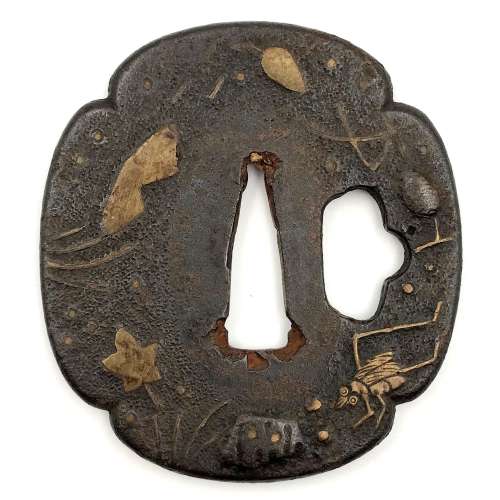 Iron tsuba of four-lobbed mokkō form decorated in brass and shakudō inlay on the face with design of rotten skull, fly, maple leaf, pine cones and needles, and on the back with design of rotten skull, wild boar, pine cones and needles. Scattered brass dots on both sides. Hitsu-ana possibly cut off later. Surface has traces of lacquer (urushi). Momoyama period. Dimensions: 67.3 x 61.5 x 4.3 mm A similar example can be found at Tsuba Kanshoki by Kazutaro Torogoye, 1975 on p. 61: "Heianjōzōgan tsuba. No sig. Iron: Pine-cone, seeds, ants & rock, brass zōgan. Kakumimi: C. 1.5 bu. Age: Momoyama. Sup. - Early work. Interest."
Iron tsuba of four-lobbed mokkō form decorated in brass and shakudō inlay on the face with design of rotten skull, fly, maple leaf, pine cones and needles, and on the back with design of rotten skull, wild boar, pine cones and needles. Scattered brass dots on both sides. Hitsu-ana possibly cut off later. Surface has traces of lacquer (urushi). Momoyama period. Dimensions: 67.3 x 61.5 x 4.3 mm A similar example can be found at Tsuba Kanshoki by Kazutaro Torogoye, 1975 on p. 61: "Heianjōzōgan tsuba. No sig. Iron: Pine-cone, seeds, ants & rock, brass zōgan. Kakumimi: C. 1.5 bu. Age: Momoyama. Sup. - Early work. Interest."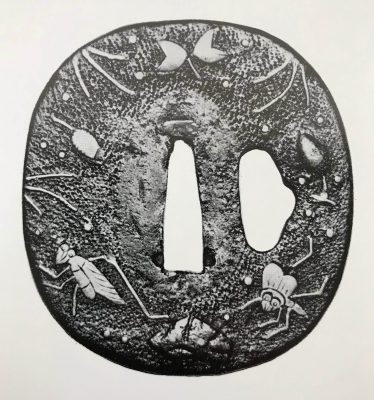
Tsuba Kanshoki, 1975, p. 61: Heianjō tsuba, Momoyama Period.
-
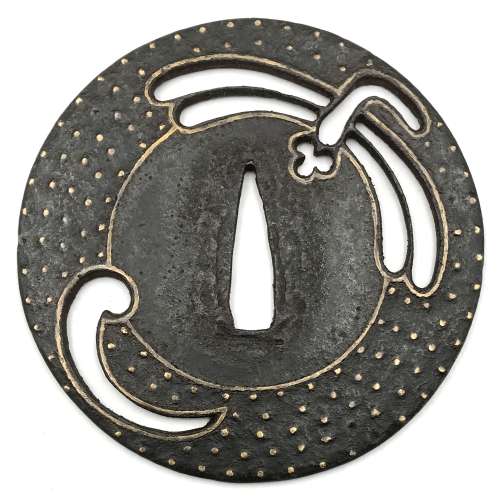 Iron tsuba of round form decorated with dragonfly (tombo) and comma (comma-like swirl, tomoe) in openwork (sukashi) outlined with brass wire. The plate decorated with 5 concentric circular rows of brass dots in ten-zōgan. Center of the plate outlined with the inlaid circular brass wire (sen-zōgan). Ōnin school. Unsigned. Mid Muromachi period, middle of the 15th century. Dimensions: Diameter: 89.5 mm, thickness: 3.1 mm. Notes regarding design: "According to various sources, the dragonfly (tombo) is emblematic of martial success, as various names for the insect are homophones for words meaning "victory". The dragonfly is also auspicious because references in the Kojiki and Nihongi link it in both name and shape to the old kingdom of Yamato." [Merrily Baird. Symbols of Japan. Thematic motifs in art and design. Rizzoli international publications, Inc., 2001, p. 108]. "The dragonfly (tonbo), was also called kachimushi in earlier times, and due to the auspicious literal meaning "victory bug" of the characters of this word it became a popular theme on sword fittings." [Iron tsuba. The works of the exhibition "Kurogane no hana", The Japanese Sword Museum, 2014, p. 13]. Helen C. Gunsaulus' description of the dragonfly emblem is as follows: "This motive, the dragon-fly (akitsu), is generally accepted as a symbol of the kingdom of Japan, and the origin of the idea is traced to the legend recounted in the Kojiki and Nihongo of the Emperor Jimmu's view of the island from mountain top. He is said to have thought the kingdom looked like a dragon-fly touching its tail with its mouth. From this it received its name Akitsu-shima... etc."
Iron tsuba of round form decorated with dragonfly (tombo) and comma (comma-like swirl, tomoe) in openwork (sukashi) outlined with brass wire. The plate decorated with 5 concentric circular rows of brass dots in ten-zōgan. Center of the plate outlined with the inlaid circular brass wire (sen-zōgan). Ōnin school. Unsigned. Mid Muromachi period, middle of the 15th century. Dimensions: Diameter: 89.5 mm, thickness: 3.1 mm. Notes regarding design: "According to various sources, the dragonfly (tombo) is emblematic of martial success, as various names for the insect are homophones for words meaning "victory". The dragonfly is also auspicious because references in the Kojiki and Nihongi link it in both name and shape to the old kingdom of Yamato." [Merrily Baird. Symbols of Japan. Thematic motifs in art and design. Rizzoli international publications, Inc., 2001, p. 108]. "The dragonfly (tonbo), was also called kachimushi in earlier times, and due to the auspicious literal meaning "victory bug" of the characters of this word it became a popular theme on sword fittings." [Iron tsuba. The works of the exhibition "Kurogane no hana", The Japanese Sword Museum, 2014, p. 13]. Helen C. Gunsaulus' description of the dragonfly emblem is as follows: "This motive, the dragon-fly (akitsu), is generally accepted as a symbol of the kingdom of Japan, and the origin of the idea is traced to the legend recounted in the Kojiki and Nihongo of the Emperor Jimmu's view of the island from mountain top. He is said to have thought the kingdom looked like a dragon-fly touching its tail with its mouth. From this it received its name Akitsu-shima... etc." -
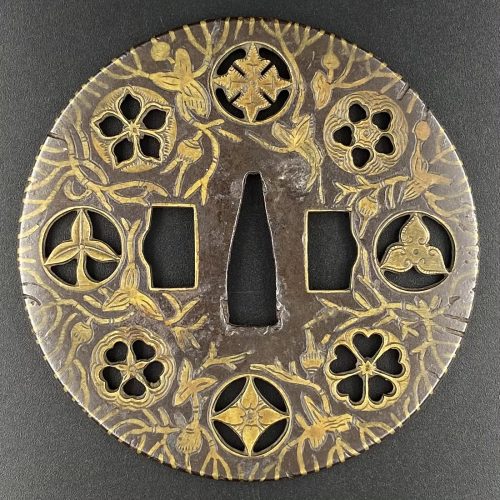 Iron tsuba of round form, tapering from centre to the rim, decorated with eight roundels – circular emblems of flowers and/or family crests (mon) made of cast brass, pierced and chiselled in kebori, and with flat brass inlay (hira-zōgan) of water plantain (omodaka) and seaweed all over the plate. Hitsu-ana outlined in brass. Four positive silhouette roundels are 3-, 6-, 9-, and 12 – pointing crests/flowers; four negative silhouette roundels – bellflower, cherry and plum blossoms. Yoshirō school (Kaga-Yoshirō). Unsigned. The Momoyama or early Edo period, end of the 16th to the first half of the 17th century (1574-1650). Size: H: 88.3 mm; W: 88.7 mm; Thickness 4.0 mm (Seppa-dai), 3,2 cm (rim). Other Kaga-Yoshiro tsuba in this collection: TSU-0334: 7.7 cm; TSU-0342.2017: 89.6 cm; TSU-0344: 8.1 cm; TSU-0329: 8.0 cm; TSU-0376.2018: 8.1 cm; TSU-0379.2018: 8.2 cm. We see that the usual size is about 8 cm; larger pieces, such as this one and TSU-0342.2017 dedicated to Hachiman, are rare. Article about Yoshiro tsuba.
Iron tsuba of round form, tapering from centre to the rim, decorated with eight roundels – circular emblems of flowers and/or family crests (mon) made of cast brass, pierced and chiselled in kebori, and with flat brass inlay (hira-zōgan) of water plantain (omodaka) and seaweed all over the plate. Hitsu-ana outlined in brass. Four positive silhouette roundels are 3-, 6-, 9-, and 12 – pointing crests/flowers; four negative silhouette roundels – bellflower, cherry and plum blossoms. Yoshirō school (Kaga-Yoshirō). Unsigned. The Momoyama or early Edo period, end of the 16th to the first half of the 17th century (1574-1650). Size: H: 88.3 mm; W: 88.7 mm; Thickness 4.0 mm (Seppa-dai), 3,2 cm (rim). Other Kaga-Yoshiro tsuba in this collection: TSU-0334: 7.7 cm; TSU-0342.2017: 89.6 cm; TSU-0344: 8.1 cm; TSU-0329: 8.0 cm; TSU-0376.2018: 8.1 cm; TSU-0379.2018: 8.2 cm. We see that the usual size is about 8 cm; larger pieces, such as this one and TSU-0342.2017 dedicated to Hachiman, are rare. Article about Yoshiro tsuba. -
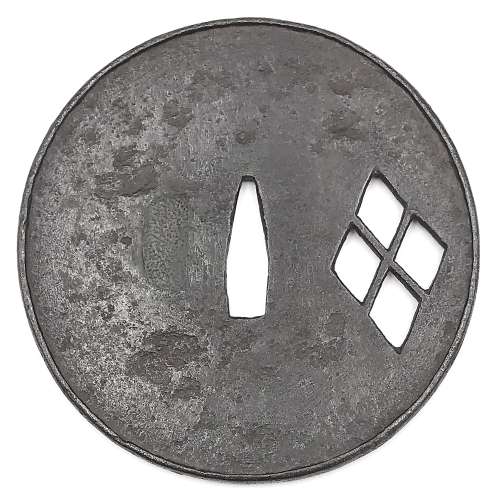 Iron tsuba of round form with design of diamond-shaped family crest (waribishi-mon) in openwork (sukashi). Bevelled, raised rim. Kozuka-hitsu-ana plugged with tin or lead. Ko-Katchushi school. Early Muromachi period: Early 15th century (Oei era). Size: Height: 89.3 mm. Width: 89.0 mm. Rim thickness: 4.3 mm. Center thickness: 2.9 mm. Provenance: Sasano Masayuki Collection, № 41: "In this tsuba, a family crest incorporating four lozenges sits upright on the right side of the nakago-ana. The straight lines of the lozenge add substance and power. Initially, the crest creates confusion regarding the age, yet the overall impression is one lacking in vigor and probably dates rather later than Nanbokucho period".
Iron tsuba of round form with design of diamond-shaped family crest (waribishi-mon) in openwork (sukashi). Bevelled, raised rim. Kozuka-hitsu-ana plugged with tin or lead. Ko-Katchushi school. Early Muromachi period: Early 15th century (Oei era). Size: Height: 89.3 mm. Width: 89.0 mm. Rim thickness: 4.3 mm. Center thickness: 2.9 mm. Provenance: Sasano Masayuki Collection, № 41: "In this tsuba, a family crest incorporating four lozenges sits upright on the right side of the nakago-ana. The straight lines of the lozenge add substance and power. Initially, the crest creates confusion regarding the age, yet the overall impression is one lacking in vigor and probably dates rather later than Nanbokucho period". -
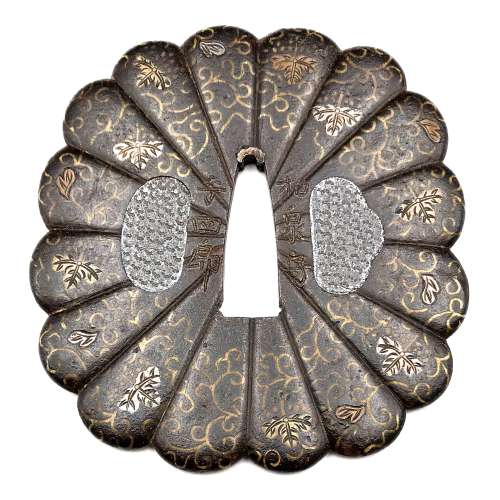 The chrysanthemoid (kiku-gata) iron plate with polished surface decorated with arabesque (karakusa) and paulownia (kiri) leaves and flowers in brass, copper and silver flush inlay (hira-zōgan) on both sides. Some of the inlay goes over the edge. Kozuka- and kogai-hitsu-ana are filled with lead plugs. Sekigane of copper. Chrysanthemum and paulownia are the symbols of imperial family. The face is signed: Izumi no Kami to the right of nakago-ana, and Yoshiro on the left; the back is signed Koike Naomasa. His signed work is considered by many experts to have been made-to-order only. The original wooden box (tomobako) with inscription (hakogaki) signed by Dr. Kazutaro Torigoye and dated Showa 39 (1964). The late Muromachi or Momoyama period, 16th century. Dimensions: 89 mm x 84 mm x 3.6 mm; Weight: 170 g. Hakogaki lid: Yoshirō kikka-gata Hakogaki lid inside: Iron, signed on the omote: Izumi no Kami – Yoshirō; on the ura: Koike Naomasa. Kikka-gata, pronounced maru-mumi, two hitsu-ana, karakusa, and kiri design in brass, silver, and suaka hira-zōgan. Height 8.5 cm, thickness 3.5 mm. Herewith I judge this work as authentic. On a lucky day in July of 1964. Torigoe Kōdō [Kazutarō] + kaō According to Robert Haynes [Catalog #7, 1983; №32, page 42-43] "This full form of the signature is seen very rarely". His example, illustrated in that catalogue, measures: height = 86 mm, thickness at seppa-dai = 3.75 mm and signed Izumi no Kami Yoshiro on the back and Koike Naomasa on the face. The further description of his specimen by Robert Haynes:
The chrysanthemoid (kiku-gata) iron plate with polished surface decorated with arabesque (karakusa) and paulownia (kiri) leaves and flowers in brass, copper and silver flush inlay (hira-zōgan) on both sides. Some of the inlay goes over the edge. Kozuka- and kogai-hitsu-ana are filled with lead plugs. Sekigane of copper. Chrysanthemum and paulownia are the symbols of imperial family. The face is signed: Izumi no Kami to the right of nakago-ana, and Yoshiro on the left; the back is signed Koike Naomasa. His signed work is considered by many experts to have been made-to-order only. The original wooden box (tomobako) with inscription (hakogaki) signed by Dr. Kazutaro Torigoye and dated Showa 39 (1964). The late Muromachi or Momoyama period, 16th century. Dimensions: 89 mm x 84 mm x 3.6 mm; Weight: 170 g. Hakogaki lid: Yoshirō kikka-gata Hakogaki lid inside: Iron, signed on the omote: Izumi no Kami – Yoshirō; on the ura: Koike Naomasa. Kikka-gata, pronounced maru-mumi, two hitsu-ana, karakusa, and kiri design in brass, silver, and suaka hira-zōgan. Height 8.5 cm, thickness 3.5 mm. Herewith I judge this work as authentic. On a lucky day in July of 1964. Torigoe Kōdō [Kazutarō] + kaō According to Robert Haynes [Catalog #7, 1983; №32, page 42-43] "This full form of the signature is seen very rarely". His example, illustrated in that catalogue, measures: height = 86 mm, thickness at seppa-dai = 3.75 mm and signed Izumi no Kami Yoshiro on the back and Koike Naomasa on the face. The further description of his specimen by Robert Haynes:"Early signed example of the work of Koike Naomasa. The kiku shape iron plate is well finished. The flush inlay is brass, for the scroll work on both sides, with the leaves and kiri mon in brass, copper and silver with strong detail carving. Some of the inlay goes almost over the edge, which is goishi gata. The large hitsuana are plugged in lead with starburst kokuin surface design. [...]The face is signed in deep bold kanji: Koike Naomasa; the back is signed: Izumi no Kami, on the right and Yoshiro on the left. There are one or two small pieces of inlay missing. Sold by Sotheby London, Oct. 27, 1981, lot 368. Height = 86 mm, thickness (seppa-dai) = 3.75 mm, (edge) = 4 mm."
Another similar example presented at: "Tsuba" by Günter Heckmann, 1995, №T55 — "Designation: Koike Naomasa. Mid Edo, end of the 17th century. Iron, hira-zogan in brass, copper, silver and shakudo, katakiri-bori. Tendrils and leaves. 87.0 x 78.0 x 4.0 mm." Reference: Japanische Schwertzierate by Lumir Jisl, 1967, page. 13. [SV: Actually, his tsuba is signed Izumi no Kami Yoshiro on the back; and Koike Naomasa on the front, exactly as Robert Haynes's tsuba. Dating this tsuba Mid-Edo, 17th century may be considered a misattribution]. More details regarding the Yoshirō tsuba. -
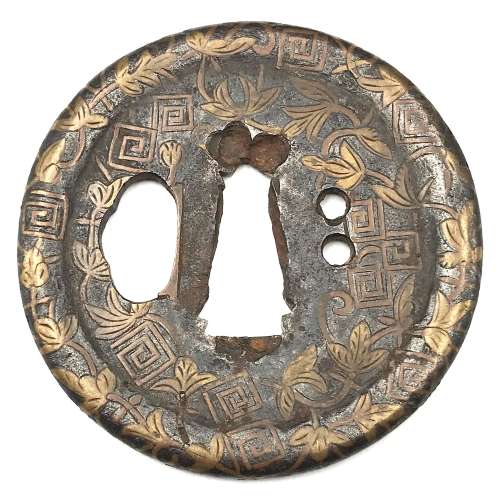
Iron tsuba of round form with dam-shaped rim (dote-mimi) pierced with hitsu-ana and two udenuki-ana (probably cut later on) decorated in flat inlay (hira-zōgan) with vines and symbols of thunder or lightning (possibly - family crest, mon). Hitsu-ana and nakago-ana with copper sekigane.
Ōnin or Heianjō school, or, possibly Kaga or Umetada school. Momoyama period or earlier (Muromachi), 16th century. Unsigned.Size: 64.5 x 63.8 x 2.2 (center), 4.2 (rim) mm.
Provenance: Lundgren Collection: [Japanese sword-fittings and metalwork in the Lundgren Collection. Published by Otsuka Kogeisha Co., Ltd., Tokyo 1992], №31; The Lundgren Collection of Japanese Swords, Sword Fittings and A Group of Miochin School Metalwork. Christie's Auction: Tuesday, 18 November 1997, London. Sales "GOTO-5881". Christie's, 1997, №2. Lundgren's description at Christie's: Heianjo tsuba. Unsigned. The circular plate decorated in brass hirazogan with flowers, plants and symbols of thunder, dote mimi and udenuki ana, late Muromachi period (16th century). Tokyo 1992 description: Sword guard with design of flowering plants and frets in inlay. Unsigned. Heianjo inlay school. 6.35 x 6.3 cm, thickness of rim 0.40 cm. Iron. Flat brass inlay. Muromachi-Momoyama Period, 16th century. Provenance: The Second John Harding. A somewhat look-a-like pieces can be found in various catalogues. The one in Naunton Collection, №172, is signed: Umetada of Yamashiro: "Iron, small, almost circular, with raised oval rim, inlaid all over with leaves and scrolls in brass hirazōgan." -
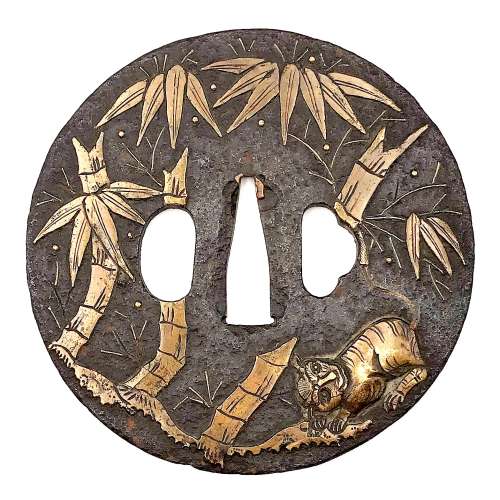 Large and thin iron tsuba of round form (width > height) decorated with the design of a tiger sheltering in bamboo in suemon-zōgan brass inlay. A fragment of tail inlay is missing. Bamboo leaves on the reverse. According to Merrily Baird [Symbols, p. 166], tiger sheltering in bamboo symbolizes "weak giving shelter to the strong". Momoyama period. Unsigned. Dimensions: 90.8 x 91.2 x 3.4 (center), 3.1 (rim) mm. Custom wooden box. NBTHK Certificate № 4001593.
Large and thin iron tsuba of round form (width > height) decorated with the design of a tiger sheltering in bamboo in suemon-zōgan brass inlay. A fragment of tail inlay is missing. Bamboo leaves on the reverse. According to Merrily Baird [Symbols, p. 166], tiger sheltering in bamboo symbolizes "weak giving shelter to the strong". Momoyama period. Unsigned. Dimensions: 90.8 x 91.2 x 3.4 (center), 3.1 (rim) mm. Custom wooden box. NBTHK Certificate № 4001593. -
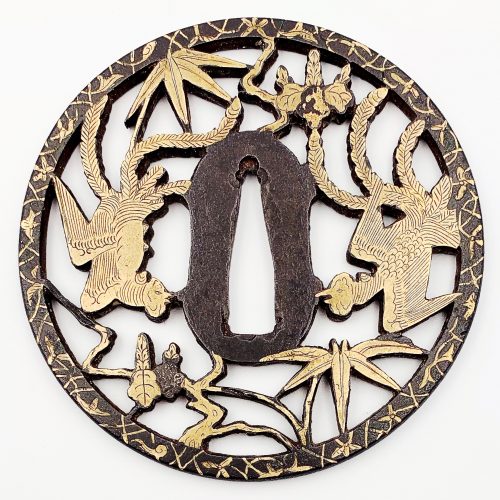
Iron tsuba of round form pierced (sukashi) and inlaid in flat (hira-zōgan) and cast brass (suemon-zōgan), details carved in kebori, with design of two phoenixes, bamboo, and paulownia leaves and flowers (kiri-mon) on both sides. According to seller: Bizen-Yoshirō school (or Heianjō school). Unsigned.
Momoyama period. End of the 16th - beginning of the 17th century. Dimensions: Diameter: 99.5 mm; Thickness: 2.1 mm at centre; 4.3 mm at the rim. According to Merrily Baird (Symbols of Japan), "bamboo teamed with paulownia blossoms or with paulownia and the phoenix, in reference to the Chinese legend that the phoenix perches only on the paulownia and eats only the bamboo". Citation from http://www.clevelandart.org/art/1986.2.1: "The immense heraldic birds on display [...] reflect the Momoyama era's spirit of newly gained self-confidence and an affinity for grand expressive statements in painting, architecture, the textile and ceramic arts, as well as garden design. While that period preceded the arrival of prosperity, it clearly marked an extraordinary moment in Japanese cultural history, one frequently compared with the twelfth century of the Heian period. [...] Rather than an emblem of immortality, as it is in Western lore, in Japan, the phoenix evolved out of its origins in Chinese mythology to become, by the sixteenth century, an auspicious symbol of political authority. Together with clusters of the distinctively shaped paulownia leaves, this long-tailed, mythical bird [...] proclaiming an air of graceful command".


